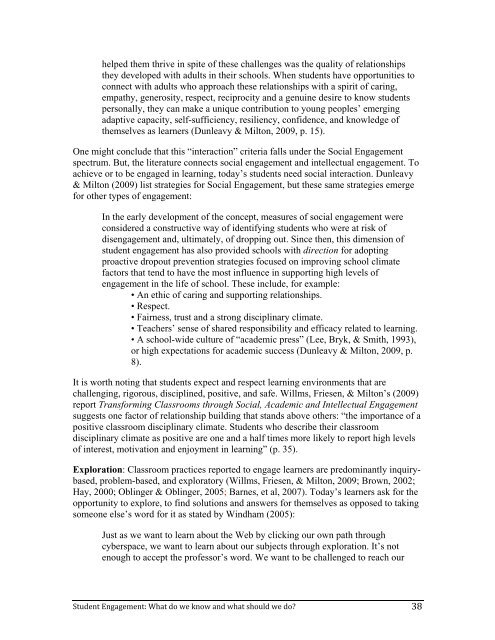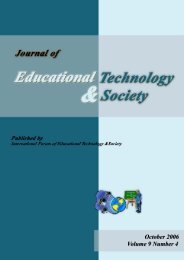Student Engagement: What do we know and what should we do?
Student Engagement: What do we know and what should we do?
Student Engagement: What do we know and what should we do?
You also want an ePaper? Increase the reach of your titles
YUMPU automatically turns print PDFs into web optimized ePapers that Google loves.
helped them thrive in spite of these challenges was the quality of relationships<br />
they developed with adults in their schools. When students have opportunities to<br />
connect with adults who approach these relationships with a spirit of caring,<br />
empathy, generosity, respect, reciprocity <strong>and</strong> a genuine desire to <strong>know</strong> students<br />
personally, they can make a unique contribution to young peoples’ emerging<br />
adaptive capacity, self-sufficiency, resiliency, confidence, <strong>and</strong> <strong>know</strong>ledge of<br />
themselves as learners (Dunleavy & Milton, 2009, p. 15).<br />
One might conclude that this “interaction” criteria falls under the Social <strong>Engagement</strong><br />
spectrum. But, the literature connects social engagement <strong>and</strong> intellectual engagement. To<br />
achieve or to be engaged in learning, today’s students need social interaction. Dunleavy<br />
& Milton (2009) list strategies for Social <strong>Engagement</strong>, but these same strategies emerge<br />
for other types of engagement:<br />
In the early development of the concept, measures of social engagement <strong>we</strong>re<br />
considered a constructive way of identifying students who <strong>we</strong>re at risk of<br />
disengagement <strong>and</strong>, ultimately, of dropping out. Since then, this dimension of<br />
student engagement has also provided schools with direction for a<strong>do</strong>pting<br />
proactive dropout prevention strategies focused on improving school climate<br />
factors that tend to have the most influence in supporting high levels of<br />
engagement in the life of school. These include, for example:<br />
• An ethic of caring <strong>and</strong> supporting relationships.<br />
• Respect.<br />
• Fairness, trust <strong>and</strong> a strong disciplinary climate.<br />
• Teachers’ sense of shared responsibility <strong>and</strong> efficacy related to learning.<br />
• A school-wide culture of “academic press” (Lee, Bryk, & Smith, 1993),<br />
or high expectations for academic success (Dunleavy & Milton, 2009, p.<br />
8).<br />
It is worth noting that students expect <strong>and</strong> respect learning environments that are<br />
challenging, rigorous, disciplined, positive, <strong>and</strong> safe. Willms, Friesen, & Milton’s (2009)<br />
report Transforming Classrooms through Social, Academic <strong>and</strong> Intellectual <strong>Engagement</strong><br />
suggests one factor of relationship building that st<strong>and</strong>s above others: “the importance of a<br />
positive classroom disciplinary climate. <strong>Student</strong>s who describe their classroom<br />
disciplinary climate as positive are one <strong>and</strong> a half times more likely to report high levels<br />
of interest, motivation <strong>and</strong> enjoyment in learning” (p. 35).<br />
Exploration: Classroom practices reported to engage learners are pre<strong>do</strong>minantly inquirybased,<br />
problem-based, <strong>and</strong> exploratory (Willms, Friesen, & Milton, 2009; Brown, 2002;<br />
Hay, 2000; Oblinger & Oblinger, 2005; Barnes, et al, 2007). Today’s learners ask for the<br />
opportunity to explore, to find solutions <strong>and</strong> ans<strong>we</strong>rs for themselves as opposed to taking<br />
someone else’s word for it as stated by Windham (2005):<br />
Just as <strong>we</strong> want to learn about the Web by clicking our own path through<br />
cyberspace, <strong>we</strong> want to learn about our subjects through exploration. It’s not<br />
enough to accept the professor’s word. We want to be challenged to reach our<br />
<strong>Student</strong> <strong>Engagement</strong>: <strong>What</strong> <strong>do</strong> <strong>we</strong> <strong>know</strong> <strong>and</strong> <strong>what</strong> <strong>should</strong> <strong>we</strong> <strong>do</strong>? 38












